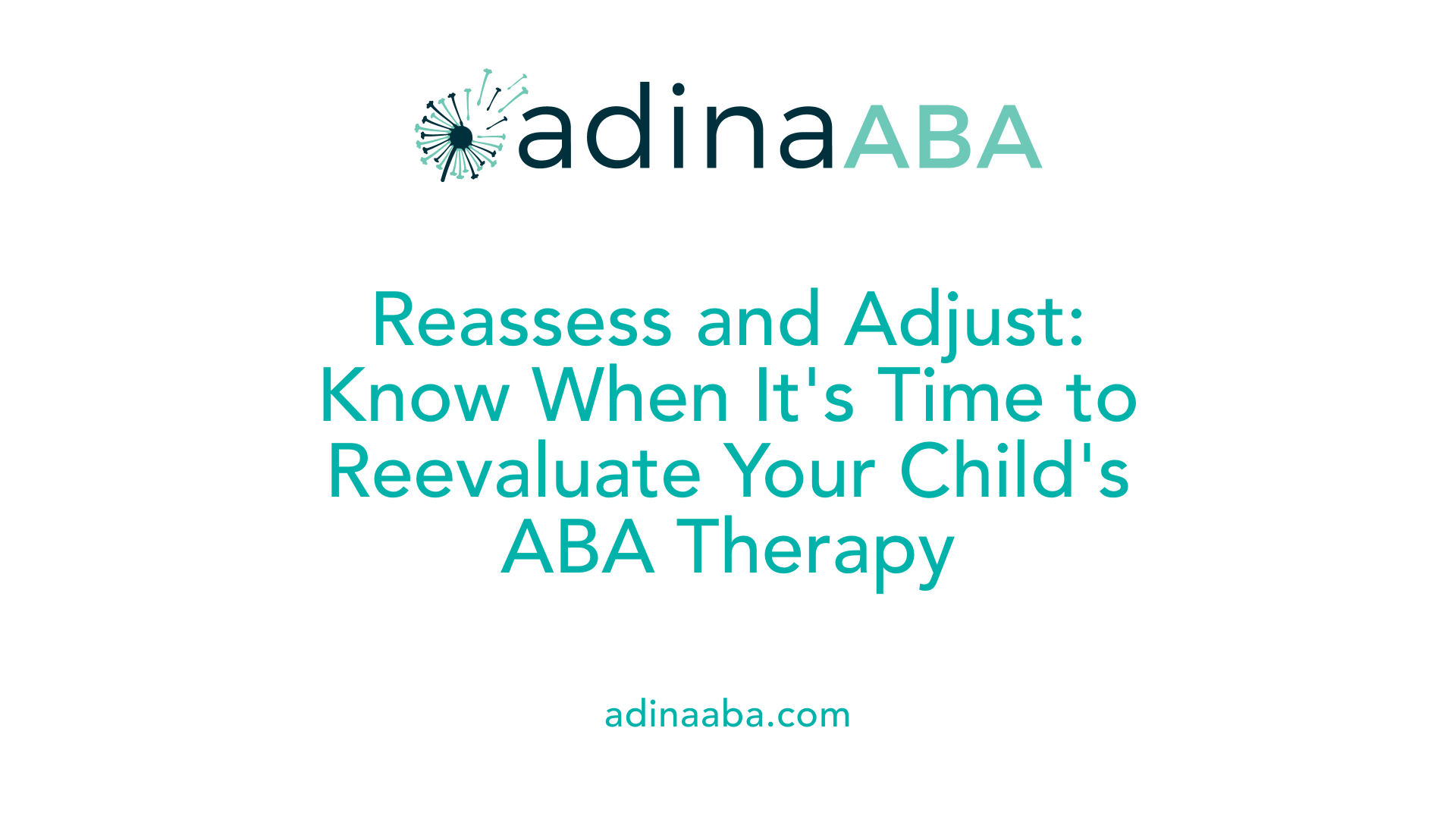Steps to take if your child plateaus in ABA therapy

Understanding and Addressing Therapy Stagnation in Children with Autism
ABA therapy is a vital intervention that can significantly improve communication, social skills, and independence for children with autism. However, progress is not always linear, and at times, children may experience a plateau—a period where their development stalls or regress. Recognizing and effectively addressing this stagnation is crucial for sustaining long-term growth. This article provides a comprehensive guide for parents to understand why their child's progress may plateau, how to recognize it early, and the strategic steps they can take to reignite their child's development.
Identifying the Causes of a Therapy Plateau
Why might a child experience a plateau in ABA therapy, and what are typical reasons?
Children undergoing ABA therapy may sometimes hit a pause in their progress. This stagnation, often called a plateau, can be caused by several factors.
One common reason is developmental variability. Children develop at different rates, and sometimes, their growth slows temporarily, which can slow down observable improvements.
Environmental factors also play a significant role. Changes in routine, new settings, or unfamiliar surroundings can disrupt a child's learning process, leading to moments of stagnation.
In some cases, the current ABA program may have reached its limit in meeting the child's needs. This signals a need for reassessment and potential adjustments to therapy goals or methods.
Resistance or anxiety related to therapy sessions—such as resistance to new tasks, avoidance behaviors, or tantrums—can also hinder progress. Such behaviors often reflect discomfort or uncertainty and can be addressed through tailored strategies.
Inconsistent participation, either due to scheduling conflicts, caregiver burnout, or environmental disruptions, affects consistency, which is vital for skill acquisition.
Behavioral escalations like hitting, self-injury, or aggression may occur when a child is overwhelmed or learning new skills too quickly. This can temporarily halt progress if not properly managed.
External influences such as fatigue, sensory sensitivities, or external stressors can also impact a child's focus and engagement.
In cases where reinforcement strategies are ineffective, or the program does not align with the child's interests or strengths, progress can stall, emphasizing the need for program adjustments.
Poor generalization—failure to transfer skills learned in therapy to other settings—can also create apparent plateaus, as skills do not appear to be functional outside the therapy environment.
Overall, recognizing these factors helps in understanding that plateaus are a normal part of development. They serve as signals for caregivers and therapists to reassess and adapt interventions, ensuring continued progress and addressing the child's evolving needs.
How Can Progress Be Effectively Monitored and Recognized?

How can progress be effectively tracked throughout ABA therapy?
Monitoring progress in ABA therapy involves multiple methods to ensure that each child's unique development is accurately understood. Systematic data collection is central, with therapists recording details like how often specific behaviors occur, how long they last, the intervals between them, and any delays in the child's responses. These detailed records help establish a clear picture of behavior patterns and skill acquisition.
Regular assessments are also crucial. Functional behavior assessments (FBAs) and skill mastery evaluations are used to gauge a child's current abilities and identify areas needing further focus. These assessments are repeated periodically to track growth and adjust treatment plans accordingly.
In addition to quantitative data, feedback from parents and therapists offers important insights. They provide qualitative observations about the child's social interactions, independence, and responses across different settings. This holistic approach ensures that progress is recognized not just through numbers but also through real-world improvements.
Visual tools such as graphs and progress reports simplify the complex data, making it easier for caregivers and team members to comprehend progress over time. These visual aids highlight trends, plateaus, or regressions, prompting timely adjustments to therapy.
In essence, combining structured data collection, ongoing assessments, and collaborative feedback creates an effective system for tracking success in ABA therapy. This comprehensive strategy supports personalized intervention, promotes continuous improvement, and ultimately helps children reach their developmental milestones.
Strategies for Parents to Support Progress During a Plateau

What strategies can parents use to support their child's progress during a plateau in ABA therapy?
When a child hits a plateau in ABA therapy, it can be frustrating for both parents and the child. However, setbacks are often temporary and can be managed effectively with the right strategies.
One of the most important approaches is maintaining consistent routines and incorporating visual aids. Using visual schedules helps children understand what to expect during their day, reducing anxiety and making transitions smoother. Consistency in therapy and daily routines provides stability, making it easier for children to focus and stay engaged.
In addition, parents can boost motivation by integrating their child's interests and preferred activities into therapy sessions. This personalization makes learning more enjoyable and naturally encourages participation, helping to break through stagnation.
Collaborating closely with therapists is vital. Parents should regularly communicate with the child's ABA team to reassess goals and strategies. Breaking down skills into manageable, smaller steps ensures that children experience success at each stage, rather than feeling overwhelmed.
Supporting learning in various environments further aids progress. Practicing skills in different settings—home, school, playground—helps children generalize what they've learned, making skills more functional and less context-dependent.
Furthermore, parents should take care of their own well-being. Seeking respite, sharing responsibilities, and celebrating small accomplishments creates a positive environment that fosters ongoing progress.
Environmental factors such as sensory sensitivities or fatigue can also influence progress. Addressing these with the help of therapists ensures children remain comfortable and receptive to learning.
In summary, a combination of structured routines, personalized activities, collaborative goal-setting, skill segmentation, and environmental awareness forms a comprehensive approach. These strategies create a supportive framework that encourages children to move past developmental stalls and continue progressing.
Modifying and Adjusting ABA Programs Post-Plateau
 When a child reaches a learning plateau in ABA therapy, it's important to review progress carefully and make thoughtful adjustments. Therapists and behavior analysts (BCBAs) rely on detailed data collection to understand why progress has stalled. This ongoing analysis helps determine which parts of the program may need change.
When a child reaches a learning plateau in ABA therapy, it's important to review progress carefully and make thoughtful adjustments. Therapists and behavior analysts (BCBAs) rely on detailed data collection to understand why progress has stalled. This ongoing analysis helps determine which parts of the program may need change.
One effective approach is to re-evaluate and modify therapy goals. Breaking complex skills into smaller, achievable steps can make learning more manageable and boost confidence. For example, if a child struggles with social interactions, dividing the skill into simple components such as initiating eye contact first, then greeting, can help.
Introducing varied reinforcement techniques is another strategy. Using different rewards or motivating activities can renew the child's interest and motivation. Teachers may also incorporate new teaching methods or environmental modifications to promote engagement.
Family involvement plays a vital role in overcoming plateaus. Parents are encouraged to reinforce skills at home and implement strategies consistently. This regular practice helps solidify learning and creates a supportive environment.
Adjustments might include changing reinforcement schedules or teaching alternative behaviors that serve the same purpose as the target skills. Tailoring interventions to fit the child's evolving needs ensures that therapy remains effective.
Overall, small, data-informed adjustments within a scientific and individualized framework can reignite progress, helping children move beyond stagnation and achieve meaningful development.
Deciding When and How to Consider Pausing or Re-evaluating ABA Therapy

When and how should parents and professionals consider pausing or evaluating ABA therapy?
Deciding to pause or review ABA therapy is a crucial step that should be taken thoughtfully. Usually, it becomes necessary when the child's progress appears to plateau or decline despite consistent efforts and adjustments. This suggests that current strategies might need re-evaluation.
A comprehensive review of the child's development is essential. This includes examining social skills, emotional regulation, behaviors, and communication abilities. Regular assessments can help determine if the interventions are still suiting the child's evolving needs and if the goals remain appropriate.
Tools like the Kindergarten Individualized Strategies Test (KIST) provide measurable data on a child's developmental progress. These assessments assist professionals in making informed decisions about continuing, adjusting, or pausing therapy.
It’s also important to evaluate the overall intensity and duration of therapy. Research indicates that both factors can significantly influence outcomes. Sometimes, a reduction in therapy hours allows the child time to consolidate skills or apply them in natural settings.
The decision to pause must be collaborative. Families, therapists, and other involved professionals should discuss the child's progress and next steps thoroughly. This teamwork ensures that the child's well-being remains central, with plans tailored to sustain progress or address setbacks.
When a pause is deemed appropriate, a structured plan should be developed. This plan might include home-based reinforcement, ongoing monitoring, and scheduled re-assessment to determine whether to resume or modify therapy strategies. Clear communication and careful planning help maintain progress and support the child's developmental journey.
Maintaining Motivation and Engagement During a Plateau
How can you keep your child motivated when progress seems to slow down?
During a plateau in ABA therapy, it’s common for children’s progress to temporarily stall or slow. To keep your child's motivation high, it’s important to make therapy sessions both fun and relevant to their interests. Incorporate creative activities that your child enjoys, like art, music, or play, which can make learning feel less like work and more like a game.
Using visual schedules and clear routines helps your child know what to expect, reducing anxiety and resistance. Visual tools like charts, pictures, or schedules provide a sense of structure, making transitions smoother and encouraging active participation.
Celebrating small successes is vital, especially when progress appears minimal. Recognize efforts with praise, small rewards, or special activities to reinforce their hard work. These positive reinforcements boost confidence and keep the child motivated to continue engaging.
Revisiting reinforcement strategies can also reignite enthusiasm. This might involve offering highly preferred items or activities as rewards or adjusting the timing or type of reinforcement to make it more motivating.
Staying connected with your child's therapists is essential. Open communication allows you to collaboratively review progress and adapt strategies. Incorporate family support and maintain consistency across home and therapy sessions to foster a unified approach.
By combining engaging activities, structured routines, positive reinforcement, and ongoing communication, you can help your child overcome plateaus and continue making meaningful strides in their development.
The Duration and Transition Out of ABA Therapy
How long does ABA therapy typically last, and when might it be appropriate to consider ending or transitioning out of therapy?
The length of ABA therapy can vary greatly from child to child. Some children may participate in support for several years, sometimes extending into adolescence or adulthood, depending on their individual progress and goals. Typically, children engage in a more intensive schedule, often between 25 to 40 hours per week, for about three to five years.
However, the need for continued therapy depends on the child's achievement of specific skills and their ability to apply these skills across different areas and environments. Therapy may be transitioned when the child consistently demonstrates progress, generalizes learned behaviors outside of structured sessions, and can learn naturally without constant prompts.
Planning a smooth transition involves preparing both the child and the family. It includes gradually reducing the frequency of therapy sessions while reinforcing skills through natural activities. Monitoring progress closely through assessments and feedback from therapists helps determine the right timing for a transition.
A collaborative decision-making process is essential. Families, therapists, and educators should evaluate whether the child can maintain skills independently or with less direct support. The goal is to foster continued growth, autonomy, and confidence, ensuring that the child continues benefiting from their developmental gains even after formal ABA support concludes.
Resources and Support for Parents Facing Challenges
What are some resources and guidance available for parents facing challenges during ABA therapy?
Parents navigating the ups and downs of ABA therapy have access to a wide range of valuable resources designed to provide support, education, and practical assistance.
Reputable websites such as Autism Speaks and the Autism Treatment Network are excellent starting points. They offer comprehensive educational materials, expert articles, and guidance on effective ABA strategies. These platforms help parents understand therapy goals, manage setbacks, and implement techniques at home.
Support groups and community organizations also play a vital role. Groups like Grateful Care ABA provide emotional support through shared experiences, peer advice, and workshops that foster resilience. Connecting with other parents can reduce feelings of isolation and encourage collaborative problem-solving.
Professional guidance remains crucial. Engaging with certified behavior analysts (BCBAs) ensures that interventions are personalized and adjusted as needed. Regular communication with therapy providers helps streamline strategies and address challenges early.
Furthermore, personalized services such as Rori Care offer tailored ABA plans and in-depth evaluations. These resources empower parents to be active participants in their child’s development, ensuring interventions suit individual needs and preferences.
In summary, accessing reputable online sources, joining support communities, collaborating with professionals, and utilizing specialized resources can provide essential guidance to parents. They help navigate difficulties, celebrate progress, and reinforce a commitment to their child's growth.
Taking Proactive Steps for Sustained Progress
While therapy plateaus can be discouraging, they are a natural part of the developmental process and provide an opportunity to reassess and fine-tune intervention strategies. By understanding the underlying causes, maintaining consistent routines, collaborating with professionals, and staying engaged with the child's interests and needs, parents can help their children break through stagnation. Regular monitoring, goal adjustment, and resource utilization ensure that ABA therapy remains responsive and effective, ultimately supporting long-term growth and independence. Remember, patience, persistence, and proactive collaboration are key to overcoming challenges and fostering continuous development.
References
- How To Navigate Success and Setbacks in ABA Therapy
- ABA Therapy Challenges: Understanding and Overcoming Obstacles
- Dealing With Setbacks In ABA Therapy? Here's What To Do!
- How to Prepare Your Child for ABA Therapy Sessions
- When to Pause ABA Therapy (and When Not To) - All Star ABA
- Autism Resources for Parents & Professionals: ABA Resources
- ATN/AIR-P Parent's Guide to Applied Behavior Analysis
- Helping Parents Understand Applied Behavior Analysis: Creating a ...
- Parent Resources - Oregon Association for Behavior Analysis
More Resources
Expert Clinicians
Get started today ->


.jpg)

.jpg)
.jpg)
